1953 Ford Prefect - Reader Resto



































|

|

|

|

|

|

|

|

|

|

|

|

|

|

|

|

|
Be it ever so humble, a fifties Ford Prefect can be a thoroughly enjoyable project
My first car, purchased in 1972, was a 1956 100E Ford Prefect bought for the princely sum of $55 with a spare car for parts. But I had to replace the big end, which cost $8.00! My brother had a Prefect wagon, called an Escort.
Many years later, when I decided it was time to get my hands on the spanners again, I was looking for a hobby car. I wanted something small, cheap and simple. I got out the trusty old Trading Post and this thing popped up. It was original, with many war wounds or battle scars, but complete, and running on three cylinders.
| Watch the video: Garry's 1953 Ford Prefect
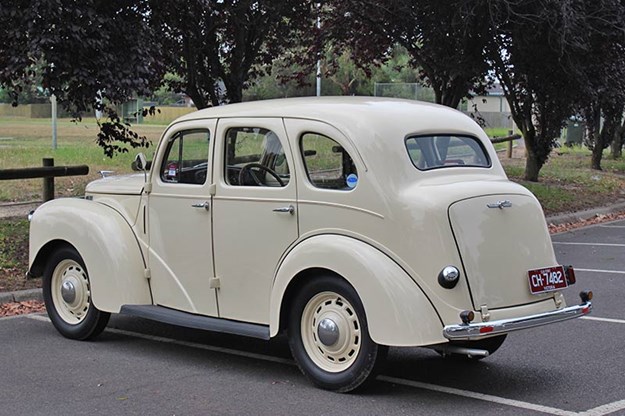
I thought we’d better clean it up to get it on the road – that was the intention. But everything I pulled off had something else underneath it that needed cleaning up too, so I ended up doing a complete bare metal restoration, every nut and bolt, which only took me almost 10 years to do.
Family obligations, health and a million other things that every family experiences seem to get in the way of finishing projects off in the time you expect.
| Read next: 1960 Borgward Isabella resto
This particular car is a 1953 Ford Prefect, A493A model. The first Prefect was 1939. Some people refer to it as an A-model Ford in different clothes. The small Fords came about because of the English road tax system that made larger cars expensive to register.
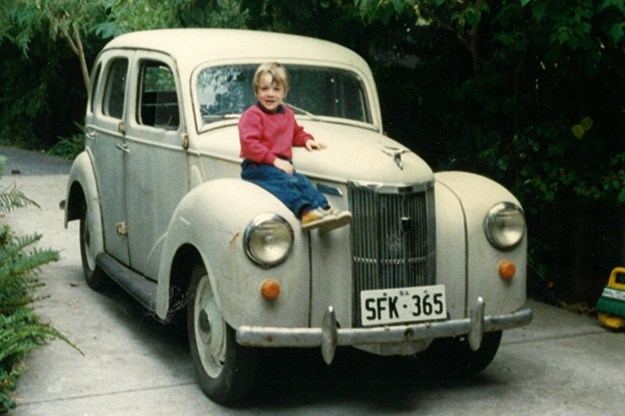
Underneath it’s transverse sprung and is powered by a small capacity (1172cc) sidevalve motor with a 10hp RAC rating. Three-speed gearbox with synchro between second and third, which was good for when they were first built.
There are no hydraulics in the car at all, no water pump (it uses thermosyphoning to circulate the coolant), and it has six volt electrics.
| Read next: 1960 Ford 105E Anglia resto
It’s very robust because of its simplicity and just about anyone could repair them. The brakes are 10-inch and are quite good for a little light car, so long as they’re properly set up.

I’ve been told that I have a great deal of patience and perseverance. It helped when finding a lot of the bits which was a bit of a nightmare. There was not much around for Australian-bodied Prefects. For English ones you could get all sorts of bits and pieces. However the rubbers and a lot of other trim are different on the local cars.
A lot of stuff I had to hunt down or modify, such as the quarter vent seals that were one of the items I filleted and glued into place. Or like the screws in the firewall, which are an obscure thread that nobody makes any more. I managed to find some left-overs from a run that Keebles in West Melbourne made. Some people say I’m too particular, but you just do it to your own satisfaction. I was never building it for a concours – I’m not the slightest bit interested in car show competitions.
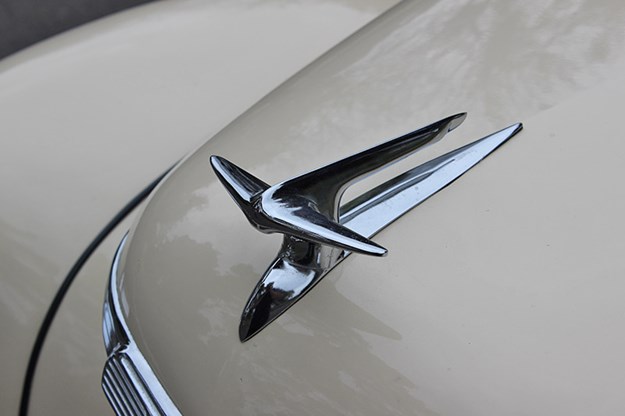
I did a full engine rebuild. These are all white-metal Babbitt mains. To get that done, even back then, was very expensive. I heard a rumour you could run Renault 4 big ends in them. It took me ages to get details and then the shells. I got the crank ground and the rods tunnel bored, which was a bit of a trick. When they bored them I had to make sure they left the side thrust white metal on the rods, because the Renault 4 shells are narrower than the genuine items. That was a bit of a challenge.
I couldn’t get new valves so I hunted around for second hand ones that were good enough. These days (the resto was done nearly a decade ago) you can get nearly everything out of Australia and England. Locally there’s a business called Yesterford, which also rebuilds a lot of components. In the UK the big supplier is Small Ford Spares.

The carburettor is a tiny single throat downdraft Zenith. Very simple and you can still find new old-stock parts.
The engine has had two minor modifications for reliability. The first is we replaced the mechanical fuel pump with a six volt electric. These tend to suffer from fuel vaporisation and having the constant pressure helps to relieve that. The second was to swap the points and condenser over for a solid state unit – the condensors can be a weak point on these.

Rustwise there was almost none. Both rear wheel arches had rust and putty patches in there. That was really the only rust in the car. Plenty of knocks and scrapes, but they can all be fixed. The roof was unmarked, the bootlid was distorted and I had to have that shrunk into shape by a panel beater.
At the time I had a mate with his own panel shop, so was able to get it done in 2- pack, just for maintenance reasons, and it’s stood up very well. Despite its compact size, it’s got quite a bit of height and presence. Interior room is surprisingly good because of the height. It’s very comfortable to ride in, though the springing is very firm. Being transversely sprung you do get tremendous body roll. One of the nicknames for these was the fall-over Ford. They do fall over if you’re cornering too aggressively, or reversing across a slope. Normal driving they’re fine.
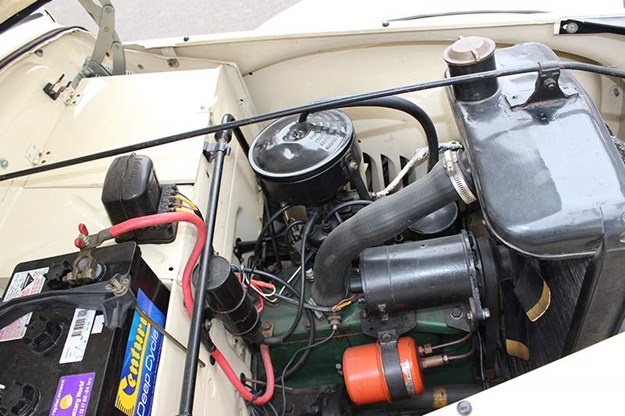
From a driver’s point of view they’re hard work compared to today’s cars, because you do have to chase them. The geometry means they follow every dip in the road and are very camber-conscious. The cross-ply tires don’t help, of course, but there are no radials that fit its wheels.
The book says the top speed is 60mph (100km/h), which would be extremely frightening. Realistically about 40-45mph (65-70km/h) is your cruising speed. It was a budget priced vehicle for a full-sized family car. Cars like the Morris and Austin were equivalent size and much more expensive. In my opinion they were much more modern cars in their mechanicals in particular. These were the cars that people could afford and were available after the war. They were reliable and relatively comfortable – that was about all you could ask it to do. The only people who had big cars were wealthy people in general as well as sales reps.
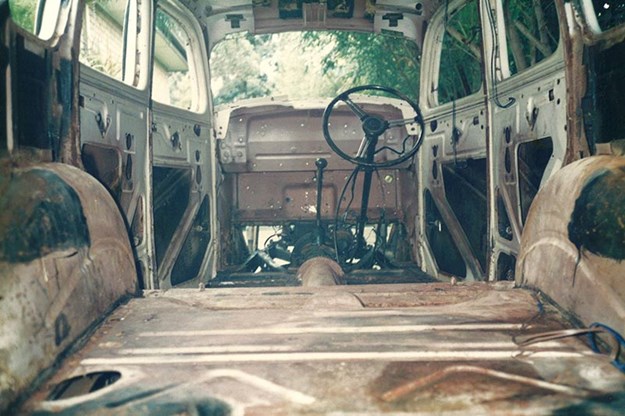 All he planned to do was give it a tidy up!
All he planned to do was give it a tidy up!
Back when these were current, apparently Melford Motors (a big dealer at the time) had a £10 ($20) engine exchange system. If your engine was tired you could book it in, drive in there in the morning, and pick it up that night with a new heart in it. Very practical.
It has ‘Made in England’ badges on the nose, though this car was assembled in Adelaide. The badges are an anomaly and would normally have appeared on the commercial models of the time. While the Australian cars used a lot of English components, the bodywork was done here and was said to be much better. For example the turret and the door skins were each one piece, rather than composites. Also, the Australian cars had an extended boot, rather than the ‘flatback’ English look..
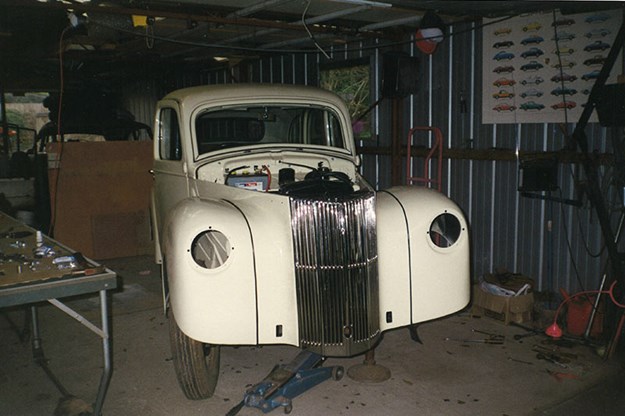 It may have been a budget car, but you have to admire the giant chrome grille
It may have been a budget car, but you have to admire the giant chrome grille
If you’re considering buying or restoring one, talk to someone and see if you can have a little drive first. It’s not the sort of car where you naturally sit back and cruise. Once you become familiar with it, you’ll let it wander and know it will come back.
They are a fun car and attract a disproportionate amount of attention at display days because everyone has got an ancient relative or whatever who has had a Prefect. They’ve all had funny stories, involving doing something like push starting it. It’s a bit of an ego boost for owners.
THE RESTORATION
 RUST EVICTION
RUST EVICTION
Other than some galloping tin worm around the rear guards, this one was pretty good..
 DAD'S BOMB
DAD'S BOMB
It’s looking like it’s been rescued from the jungle. Garry’s kids unkindly referred to it as "Dad’s bomb car".
 PROGRESS
PROGRESS
Now we’re getting somewhere with the basic chassis looking pretty tidy in its fresh paint.
 SIMPLICITY
SIMPLICITY
The tiny side-valve engine got a complete rebuild, using Renault 4 big-end shells!
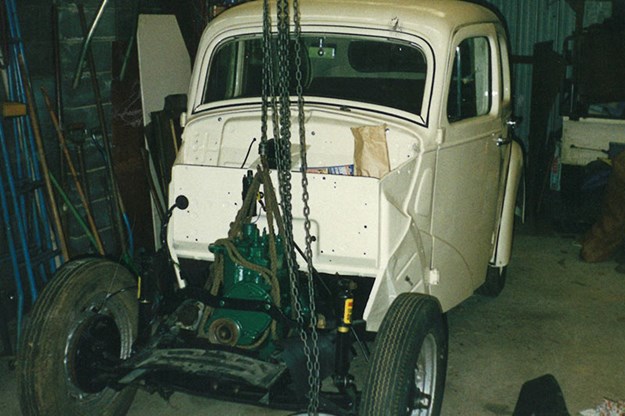 A BIG MOMENT
A BIG MOMENT
It’s a key moment in any resto, dropping the heart back in. Now it’s starting to look like a car again.
 HIGH AND DRY
HIGH AND DRY
We’re at that stage where it’s looking close, but there are a squillion little tasks to be tackled.
1953 Ford Prefect specs
Engine: 1198cc sidevalve four
Power & torque: 22kW @4000rpm (10hp tax rating) 63Nm @2400rpm
Top speed: 100km/h
Transmission: Three-speed manual
Suspension: Transverse leaf springs with hydraulic dampers
Brakes: Mechanical drums
Classic Australian Family Car Value Guide home page
Muscle Car Value Guide home page
Japanese Classic Car Value Guide home page
Unique Cars magazine Value Guides
Sell your car for free right here
Get your monthly fix of news, reviews and stories on the greatest cars and minds in the automotive world.
Subscribe

.jpg)











